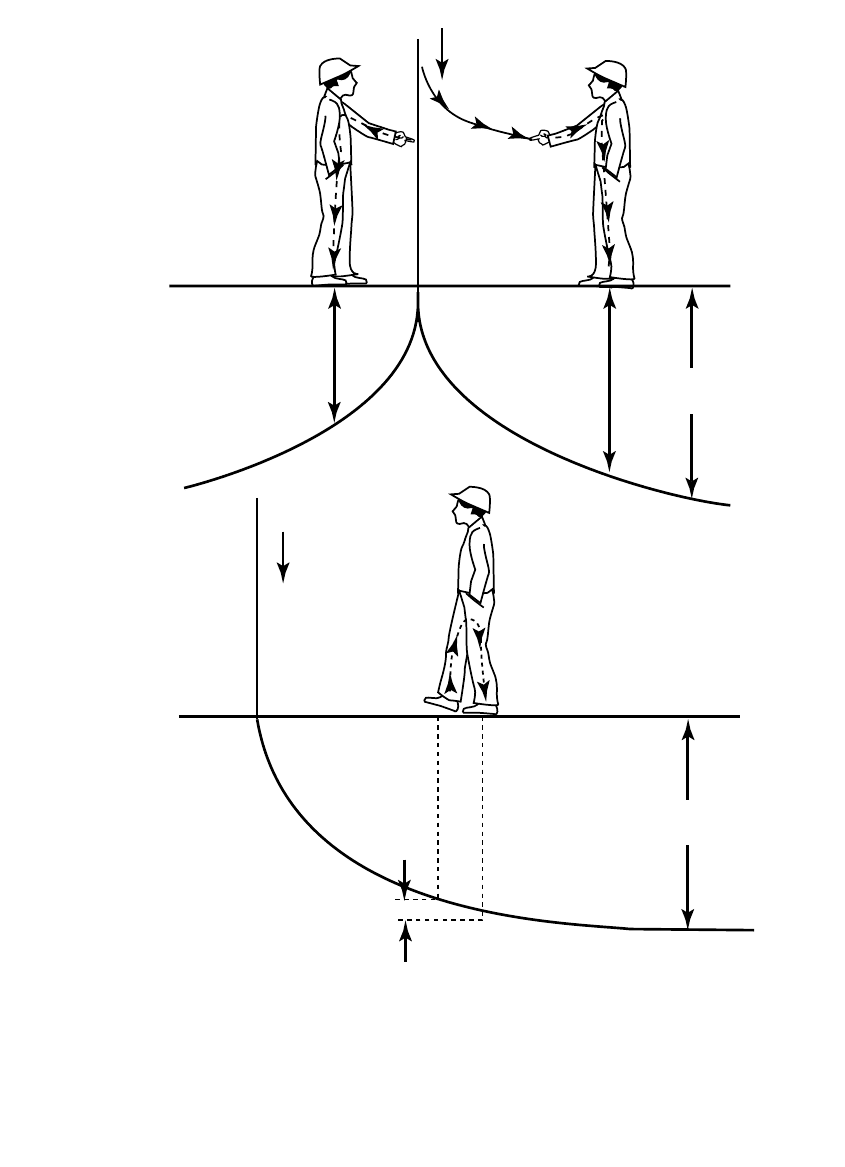Short T.A. Electric Power Distribution Handbook
Подождите немного. Документ загружается.


Grounding and Safety 679
varies with depth. But keep in mind that other buried equipment, pipes or
cables, may give false readings.
13.5 Shocks and Stray Voltages
Contact with high voltage utility circuits poses dangers to utility workers
and the public. Electricity is dangerous. Just a small amount of current
through a person’s body can kill. Backhoes, kites, downed wires, trees into
lines — direct and indirect contacts to utility circuits may occur in many
ways. When equipment fails or external factors cause line-to-ground faults,
current flow into the ground can pose step and touch potential hazards to
the public and to utility workers. Many electric dangers are invisible. When
a crane boom accidentally contacts an overhead primary wire, there may be
no visible or audible indications from the ground to warn someone, to pre-
vent someone from grabbing the crane’s door handle and being electrocuted.
Even under normal operating conditions, the multigrounded neutral may
be imperfectly grounded and may have a voltage above that of true ground.
Under certain conditions, this voltage potential may shock people when they
touch metallic equipment that is connected to the neutral. These same “stray
voltages” also cause concern on dairy farms and other agricultural facilities.
Given all of the possible hazards in dealing with high voltage and given
the great lengths of distribution line in operation, utilities do a very good
job of safely operating their lines and minimizing accidents. Several compo-
nents help maintain a safe system — designs with good clearances and ample
mechanical strength, public education to avoid things like kites into over-
head lines, proper overcurrent protection schemes, effective grounding, and
rapid response and repair.
13.5.1 Biological Models
The body’s resistance is an important part of the electrical circuit in possible
shocking situations. The body’s internal resistance is about 300 W. Resistance
including the skin contact resistance is in the range of 500 to 5000 W [(IEEE
Std. 80-2000) and many other publications] but varies widely as shown in
Table 13.5. It is common to use a resistance of 1000 W and assume that the
hand and foot contact resistances are zero (as in IEEE Std. 80-2000). The 1000
W is used for the path from one hand to the other, from hand to foot, and
from foot to foot (all are roughly the same impedance). Much of this imped-
ance is concentrated at the extremities, the forearm, and the ankle and shin.
For more information on biological impacts and models, see Reilly (1998)
and the IEEE Working Group on Electrostatic and Electromagnetic Effects
et al. (1978).
1791_book.fm Page 679 Monday, August 4, 2003 3:20 PM
(C) 2004 by CRC Press LLC

680 Electric Power Distribution Handbook
Electric current does the damage. Table 13.6 shows electrical effects on
people for different ranges of currents. Currents as low as 0.1 mA are per-
ceptible to some, and currents above 1 mA are perceptible to most. Above
the “let-go” current, at about 5 to 25 mA, the hand and arm muscles invol-
untarily clench, and a person may be unable to release an electrified object.
These current levels may be quite painful but do not cause permanent
damage. A person may have severe breathing difficulties for currents above
30 mA, which in some cases may cause death.
Electrocution can occur for currents through the heart on the order of 60
to 100 mA; 250 mA through the heart is almost always fatal (without life-
saving emergency care). These levels of current interfere with the heart’s
internal electrical pacemaker and force the heart to stop beating properly.
During this ventricular fibrillation, the heart muscle fibers contract erratically
and unpredictably, leading quickly to death from lack of oxygen to the brain.
Above 5 A, current can burn tissue.
The destructive effect of current is a function of the energy into the body;
assuming a constant resistance, the energy input is a function of I
2
t. One
commonly cited model, Dalziel’s formula, describes the relationship between
fibrillation and the duration of current (Dalziel, 1946; Dalziel, 1972) as
where
I = minimum body current in mA necessary to cause ventricular fibrilla-
tion for at least 0.5% of the population for a 110-lb (50-kg) adult
t = duration of the current, sec
TABLE 13.5
Human Resistance Values for Several Contact Conditions
Resistance Range, WW
WW
Dry Wet
Finger touch 40,000–1,000,000 4000–15,000
Hand holding wire 15,000–50,000 3000–6000
Finger-thumb grasp (interpolated) 10,000–30,000 2000–5000
Hand holding pliers 5000–10,000 1000–3000
Palm touch 3000–8000 1000–2000
Hand around 3.8 cm (1.5 in.) pipe (or drill handle) 1000–3000 500–1500
Two hands around 3.8 cm (1.5 in.) pipe 500–1500 250–750
Hand immersed in water 200–500
Foot immersed in water 100–300
Human body, internal, excluding skin 200–1000
Source: Lee, R. H., “Electrical Safety in Industrial Plants,” IEEE Spectrum, June 1971. With
permission. ©1971 IEEE. (Also in IEEE Std. 902-1998, IEEE Guide for Maintenance, Oper-
ation, and Safety of Industrial and Commercial Power Systems.)
I
t
=
116
1791_book.fm Page 680 Monday, August 4, 2003 3:20 PM
(C) 2004 by CRC Press LLC

Grounding and Safety 681
Larger people are able to withstand higher currents. A more general for-
mulation of Dalziel’s formula includes body weight as
TABLE 13.6
Threshold Levels for 60-Hz Contact Currents
rms Current
mA Threshold Reaction/Sensation
Perception
0.09 Touch perception for 1% of women
0.13 Touch perception for 1% of men
0.24 Touch perception for 50% of women
0.33 Grip perception for 1% of women
0.36 Touch perception for 50% of men
0.49 Grip perception for 1% of men
0.73 Grip perception for 50% of women
1.10 Grip perception for 50% of men
Startle
2.2 Estimated borderline hazardous reaction, 50% probability for women
(arm contact)
3.2 Estimated borderline hazardous reaction, 50% probability for women
(pinched contacts)
Let-Go
4.5 Estimated let-go for 0.5% of children
6.0 Let-go for 0.5% of women
9.0 Let-go for 0.5% of men
10.5 Let-go for 50% of women
16.0 Let-go for 50% of men
Respitory Tetanus
15 Breathing difficulty for 50% of women
23 Breathing difficulty for 50% of men
Fibrillation
35 Estimated 3-s fibrillating current for 0.5% of 44-lb (20-kg) children
100 Estimated 3-s fibrillating current for 0.5% of 150-lb (70-kg) adults
Source: IEEE Working Group on Electrostatic and Electromagnetic Effects, Delaplace,
L. R., and Reilly, J. P., “Electric and Magnetic Field Coupling from High Voltage AC
Power Transmission Lines — Classification of Short Term Effects on People,” IEEE
Transactions on Power Apparatus and Systems, vol. PAS-97, no. 6, pp. 2243–52, November/
December 1978. ©1978 IEEE.
I
S
t
=
1791_book.fm Page 681 Monday, August 4, 2003 3:20 PM
(C) 2004 by CRC Press LLC

682 Electric Power Distribution Handbook
where
S = body weight, kg
Dalziel’s formula applies for the time ranges of faults, from about one-half
cycle to 3 sec (it may not apply for longer- or shorter-duration currents).
Electricity can kill at astonishingly low energies. A 100-mA current through
a body resistance of 500 W is only 50 W of power.
If an electrical shock stops someone’s heart, cardiopulmonary resuscitation
(CPR) can supply some oxygen to the brain until emergency care arrives. In
many cases, resuscitation after electrical shocks is possible with a defibrilla-
tor. The electric current causing ventricular fibrillation shuts down the heart’s
electrical system but may not significantly damage organs or nerves. Note
that a victim of fibrillation may not immediately become unconscious and
can deny needing help (death may be quick or take hours). Always call
emergency help immediately, and apply CPR if appropriate (but be careful
not to apply CPR to someone whose heart is not in fibrillation).
Currents above 5 A can permanently burn tissue. Fast fault clearing helps
reduce the amount of tissue damage and increases the likelihood of success-
ful emergency care.
While current does the damage, voltage plays an important role. Normally,
120-V secondary voltages are not as dangerous as higher voltages (but 120
V kills many people every year). In many shocking situations, 120 V may
produce painful shocks but not kill (the circuit resistance including contacts
is often high enough to limit the current). But 120 V can kill: remember
bathtubs. Current in the path depends primarily upon what resistance is in
the current’s path — wet vs. dry skin, shoe resistance, glove resistance, and
other impedances in the circuit path. To reach 100 mA, the total resistance
must be less than 1200 W, which can happen, especially if contacted when
wet. Higher secondary voltages such as 480 V are more likely to kill. Above
600 V, the skin offers no extra resistance; the voltage punctures right through,
leaving only the internal body resistance or about 300 W. Above 2400 V, the
voltage drives currents high enough for burning and tissue damage.
13.5.2 Step and Touch Potentials
Step and touch potentials are very important in substations because during
ground faults, all of the ground current returns to the substation transformer.
The current that returns through the earth can create a significant voltage
gradient along the ground and between the ground and conducting objects.
A touch potential is normally considered a hand-to-foot or a hand-to-hand
contact; a step potential creates a path through the legs from one foot to the
other (see Figure 13.18).
The approximate impedance of one foot-to-ground contact is
1791_book.fm Page 682 Monday, August 4, 2003 3:20 PM
(C) 2004 by CRC Press LLC

Grounding and Safety 683
FIGURE 13.18
Paths for touch and step potentials. (From WAPA, Power System Maintenance Manual, Chapter
1: Personal Protective and Vehicle Grounding, Western Area Power Administration, U.S. Depart-
ment of Energy, 1997.)
Fault
Touch
Voltage
Step
Voltage
Transferred
Touch
Voltage
Conductive
Element
Fault
(See Note)
Voltage
Rise
Voltage
Rise
Touch Voltage
Step Voltage
A conductive element
may be a tool, cable,
vehicle, or any object
capable of transferring
a fault.
NOTE:
1791_book.fm Page 683 Monday, August 4, 2003 3:20 PM
(C) 2004 by CRC Press LLC

684 Electric Power Distribution Handbook
R = 3r
where
r = earth resistivity, W-m
For a step potential, two of the foot-contact resistances are in series with
the body resistance R
B
, so the body current I
B
is
With a hand-and-feet touch potential, the circuit impedance is two foot-
contact resistances in parallel plus the body resistance. For a touch potential,
the body current is
Step and touch potentials are of concern during normal conditions and
during a ground fault. Under normal conditions, unbalanced current can
raise the neutral-to-earth voltage. This is not normally dangerous, but it can
cause annoying shocks and concerns on farms (see the next section on stray
voltage). Step and touch potentials during faults are more dangerous. This
is an important design consideration in substation grounding. Unfortunately,
outside the substation we cannot control many situations nearly as well. The
multigrounded neutral helps reduce the chance of dangerous step-and-touch
potentials during line-to-ground faults. First, by creating a low-impedance
path back to the source, faults are cleared quickly by fault interrupters. And,
having multiple grounding electrodes tied together helps reduce touch
potentials at the fault point. Away from the substation on systems with
multigrounded neutrals, step potentials are usually not dangerous since fault
current spreads between several grounding electrodes.
Simulations by Rajotte et. al. (1990) help define the touch potentials
between the multigrounded neutral and the earth. Figure 13.19 shows neu-
tral-to-earth voltages on overhead and underground systems for different
fault locations and earth resistivities. Underground circuits have touch volt-
ages an order of magnitude less than overhead circuits because less current
flows in the earth due to the cable neutral being the preferred return path
(the reason being the tight coupling with the phase conductor).
The highest ground potential rise is normally at the fault location, but
Rajotte simulated cases where an underground section followed an overhead
section: the maximum potential rise was sometimes at the pothead rather
than the fault location.
I
V
R
B
step
B
=
+ 6r
I
V
R
B
touch
B
=
+ 15. r
1791_book.fm Page 684 Monday, August 4, 2003 3:20 PM
(C) 2004 by CRC Press LLC

Grounding and Safety 685
Using a reactor on the substation transformer neutral helps limit step-and-
touch potentials. While utilities normally use these neutral reactors to limit
fault currents, the reduction of the ground fault current also reduces step-and-
touch potentials and reduces current in grounding and bonding connectors.
13.5.3 Stray Voltage
Stray voltage is a touch voltage that end-users experience. Stray voltage
causes complaints from residential customers, but most concern has centered
around dairy farms. On farms, milking cows are subjected to a voltage
between the milking equipment and the earth they are standing on. Cows
and people have somewhat similar discomfort responses. Currents above 1
mA may cause discomfort for cows. The Wisconsin Public Service Commis-
sion defines a “level of concern” of 1 V for the cow contact voltage, which
corresponds to 2 mA of current through a 500 W resistor (Reines et al., 1995).
Figure 13.20 shows a U.S. Department of Agriculture guideline on the effects
of stray voltage on milk production.
The amount of current through an animal’s body depends on the neutral-
to-earth voltage, the animal’s resistance, and the characteristics of the soil
(especially its moisture) and/or concrete.
FIGURE 13.19
Neutral-to-earth voltages during line-to-ground faults on 25-kV overhead and underground
circuits. (Adapted from Rajotte, Y., Bergeron, R., Chalifoux, A., and Gervais, Y., “Touch Voltages
on Underground Distribution Systems During Fault Conditions,” IEEE Trans. Power Delivery,
5(2), 1026-1033, April 1990. ©1990 IEEE. With permission.)
012345
0 500 1000 1500 2000 2500
Distance between the substation and fault, km
Ground potential rise at the fault location
(overhead fault) (volts)
Ground potential rise at the fault location
(underground fault) (volts)
050100 150 200 250
Overhead fault
Underground fault
10000Ω-m
1000Ω-m
100Ω-m
1791_book.fm Page 685 Monday, August 4, 2003 3:20 PM
(C) 2004 by CRC Press LLC

686 Electric Power Distribution Handbook
Stray voltage at barns is normally measured across a 500-W resistor, which
represents the typical resistance of a cow.
Stray voltage has stirred significant public attention. The “danger” of stray
voltage has been exaggerated in some articles in the press. Studies have
found mixed results when trying to quantify the effect of stray voltage on
milk production, reduced food or water intake, somatic cell count, and other
important physiological effects. The Wisconsin Public Service Commission
database of stray voltage field surveys found little correlation between milk
production and electrical parameters such as cow contact current (Reines et
al., 1995; Reines et al., 1998). A report of scientific advisors to the Minnesota
Public Utilities Commission found some correlation between stray voltage
and high-health herds and low-health herds, but other factors were more
significant (Minnesota Public Utilities Commission, 1998). The CEA (1992)
found no significant effect on cows’ behavior or production for stray voltages
of 1 or 2.5 V. Some change in water and feed consumption were noted for
5-V stray voltages.
Many stray voltage problems are due to improper facility grounding and
bonding. The National Electrical Code (NEC) (NFPA 70, 2002) covers the
issues that could cause problems. Many stray voltage problems originate on
the secondary system. Improper bonding or other violations of the NEC can
create excessive voltages between equipment frames and the earth. Another
common problem is failed equipment insulation — a failure to a bonding
FIGURE 13.20
Milk production and behavioral responses to stray voltage based on current. (From [USDA,
1991].)
Current, mA
02468
01234
02468
Voltage (V)
Behavioral response
Milk production response
500 W
1 KW
None
Perception only
Moderate
Severe
No loss
in production
anticipated
Any loss
in production is not due
to change in animals
Production loss
may be due to
change in animals
1791_book.fm Page 686 Monday, August 4, 2003 3:20 PM
(C) 2004 by CRC Press LLC

Grounding and Safety 687
frame (in a motor, for example) can create stray voltages but not draw enough
current to blow a fuse or trip a breaker. So, identifying if the problems
originate on the secondary is the first step in any stray voltage problem. The
easiest way to determine if secondary problems are the culprit is to trip the
main breaker or pull the meter. If the stray voltage exists after the secondary
loads have been removed, then local problems are ruled out; the problems
are likely due to a primary neutral-to-earth voltage or a secondary voltage
due to other customers on the same secondary. Secondary-side fixes include
using a larger neutral, fixing poor neutral connections, balancing 120-V load,
and fixing NEC grounding or bonding violations.
Regardless of the origin of the stray voltage, localized bonding can elim-
inate touch potentials. In a barn, we can bury wires or sheets of metal just
under the earth that a cow stands on during milking. Bonding the buried
wires or sheets to the milking equipment creates an equipotential plane that
eliminates shocks during milking. Another local solution option is an active
voltage suppression device that reduces shocks by actively countering the
stray voltage.
EPRI (1999) investigated several residential stray voltage problems, many
related to swimming pools. Pools are often involved in shock incidents
because wet skin has lower resistance and is more susceptible to shock. Many
pool-related shocking sensations were found in cases where handrails, lad-
ders or decks were not bonded. The NEC requires all metallic parts of a pool
to be bonded together including ladders, concrete decks, and diving boards
as well as lights and pumps. Voltage differences between bonded and
unbonded metal or conducting elements cause shocking situations. The
bonded parts of the pool are at the neutral potential (which may be at an
elevated potential relative to the earth). Unbonded parts float to a different
voltage. Decks in contact with the earth that are not bonded will be at earth
potential. Bonding helps eliminate annoying shocks, but more importantly,
it reduces the chance of electrocution if the unbonded part happens to
become energized at 120 V. Hot tubs and outdoor water faucets are also
involved in shocking incidents (faucets are grounded, the soil beneath is at
earth potential).
Neutral-to-earth voltages cannot be analyzed with existing load-flow pro-
grams. To accurately model stray voltage, a more general steady-state circuit
analysis program such as EMTP is needed. Accurate modeling involves
modeling the neutral and the individual grounding electrodes.
Neutral-current harmonics can occasionally contribute to stray voltages,
primarily from the third harmonic which adds in the neutral [see Tran et al.
(1996) for a more complete analysis]. Leap et al. (2002) showed an example
where the rms stray voltage at one location on Portland General Electric’s
system increased from 0.4 V to 8.3 V after adding a 1200-kvar capacitor bank.
The capacitor resonated with the system impedance and drew third har-
monic current into the neutral, enough to significantly raise the neutral
voltage relative to remote earth. Reducing the size of the capacitor to 300
kvar reduced the stray voltage acceptably.
1791_book.fm Page 687 Monday, August 4, 2003 3:20 PM
(C) 2004 by CRC Press LLC

688 Electric Power Distribution Handbook
Figure 13.21 shows distributions of the neutral impedance measured at
several locations on 16 rural feeders (Rajotte et al., 1997). Even though the
ground resistances of these circuits varied over orders of magnitude, the
neutral impedance stayed consistent and fairly low. This highlights one of
the main advantages of the multigrounded neutral — many grounds over-
come poor ground resistivity, providing an effective return path regardless
of the performance of individual grounds. Even with such low impedances,
neutral-to-earth voltages can reach several volts given enough current
unbalance.
High neutral-to-earth voltages are more likely near the substation and far
from the substation. Utility-side solutions to stray voltage include
• Balancing — Balancing load among the phases reduces the earth-
return current (and thus the neutral-to-earth voltage).
• Single-phase lines — Converting single-phase sections to two or three
phase reduces the neutral-to-earth voltage.
• Neutral — Upgrading the neutral size provides a lower-impedance
path for earth-return current.
• Capacitor banks — Check capacitor banks for blown fuses. If a
grounded-wye capacitor has a blown fuse, the unbalance can create
excessive neutral current.
Another utility option is to use a neutral isolation device. Isolating the
secondary neutral keeps utility neutral-to-earth voltages away from cus-
tomer equipment. Keeping the primary neutral separate from the secondary
is difficult. Make sure phone, cable television, and metal water pipes are all
FIGURE 13.21
Distribution of measured impedances of the multigrounded neutral on rural circuits. (Data
from [Rajotte et al., 1997].)
0 1 2 3
0
25
50
75
100
Impedance, ohms
Percentage of sites with impedance
exceeding the x-axis value
1791_book.fm Page 688 Monday, August 4, 2003 3:20 PM
(C) 2004 by CRC Press LLC
